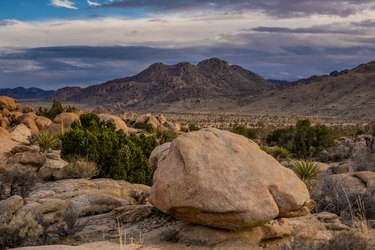
The difference between a rock and a boulder can be explained in terms of size and detachment. A rock is defined by geologists as an aggregate of minerals. A boulder is a type of rock, specifically a large detached one. All boulders are rocks, but not all rocks are boulders.
Definition Of a Rock
Video of the Day
Webster's New American Dictionary defines rock as ''a mass of stony material.'' Rocks come in all sizes, from specks of silt to towering mountains. They are formed over thousands of years by pressures and temperatures in and under the earth's crust. Rocks are made from the crystals of one or more minerals in varying compositions, according to ''Rocks and Minerals.'' For example, quartz, feldspar and mica crystals combine to make granite.
Video of the Day
Definition Of a Boulder
Webster's defines a boulder as ''a large detached rounded or worn mass of rock.'' Elfi Berndl, an educator and member of the Central Canadian Federation of Mineralogical Societies, launched a website in 1999 to educate children about types of rocks. According to Berndl, there are many common names for rocks, and these give us an idea of how large the rock is. The term ''boulder,'' for example, is one of these common names for rocks. Boulder is used to describe a large rock that is ''taller than a person.''
Terms for Rock Sizes
Using Berndl's terminology, the largest rock is a mountain, which is defined as "a giant rock still attached to the earth's crust.'' A boulder would fall next in the line according to size. Other descriptive rock words are stone (a rock you can hold in two hands) and pebble (small enough to hold with two fingers). Tiny bits of rock can be called sand, grain, dust and speck.
Types of Rocks
All rocks and boulders fall into one of three categories--igneous, sedimentary or metamorphic--based on their origin. Igneous rocks are solidified from molten lava. Examples are granite and pumice. Spectacular displays of igneous rocks are the volcanoes of Hawaii and the volcanic rocks of Yellowstone National Park.
Sedimentary rocks are formed at or near the earth's surface by the accumulation of particles. They have a layered look, and examples are sandstone and chalk. The Grand Canyon is a colorful display of sedimentary rock. Metamorphic rocks result from changes to preexisting igneous, sedimentary or metamorphic rocks by high pressures and temperatures. Marble and slate are examples. Metamorphic rocks are typically found in mountain areas, such as the Appalachians.
Rocks & Humans
Humans first used rocks and boulders millions of years ago. Rocks were the first tools and the earliest canvases for artwork. Rock caves were among the first dwelling places of humans. Later, humans used types of rock to build sacred monuments, such as the pyramids of Egypt.
Today humans have a myriad of uses for rocks, such as in computers (quartz), pottery (clay), toothpaste (fluorite), sandpaper (garnet) and talcum powder (limestone). Rocks are used to build walls and decorate landscapes. Boulders, for example, are used in Japanese gardens to represent mountains. Stones can border a flower bed, and gravel can be made into a pathway or raked into a pattern to simulate flowing water.